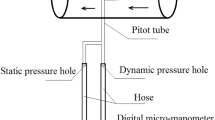Abstract
“The Guide to the Expression of Uncertainty in Measurement” (GUM) method has many disadvantages when evaluating the uncertainty of wind speed measured by pitot tube, and the “Monte Carlo method” (MCM) is put forward to evaluate the uncertainty of wind speed. The measured quantity value of wind speed by the S-shaped pitot tube is the research object, and the uncertainty is evaluated by GUM and MCM, respectively, and the simulation test is carried out. GUM has errors due to its adoption of approximate linear model. MCM adopts real simulation strategy and has higher credibility than the GUM method, so the GUM method can be validated by the MCM method. When the partial input quantity is changed into triangular distribution, uniform distribution and arcsine distribution, the GUM method is found to be inapplicable. In the evaluation of MCM method, the complex calculation of sensitivity coefficient is avoided, and some uncertainty with small influencing quantity is not needed to be discarded. The evaluation result is more complete. Through comparing the uncertainty evaluation results of MCM before and after the water vapor correction term is discarded, the influence of the water vapor correction term is quantified. Therefore, compared with the GUM method, the MCM method has more advantages when wind speed is measured by pitot tube.





Similar content being viewed by others
References
ISO/IEC Guide 98-3: 2008, Uncertainty of Measurement—Part 3: Guide to the Expression of Uncertainty in Measurement (GUM) (2008).
GUIDE 98-3/SUPP.1, Uncertainty of Measurement—Part 3/Supplement 1: Propagation of Distributions Using a Monte Carlo Method. ISO/IEC (2008).
W.A. Cooper, S.M. Spuler, M. Spowart, D.H. Lenschow and R.B. Friesen, Calibrating airborne measurements of airspeed, pressure and temperature using a Doppler laser air-motion sensor, Atmos. Meas. Tech., 7(9) (2014) 3215–3231.
M.L. Fravolini, G. del Core, U. Papa, P. Valigi and M.R. Napolitano, Data-driven schemes for robust fault detection of air data system sensors, IEEE Trans. Control Syst. Technol. 99 (2017) 1–15.
H. Yin and R. Zivanovic, An application of probabilistic collocation method in wind farms modelling and power system simulation, Innovative Smart Grid Technologies-Asia (ISGT-Asia). IEEE (2016), pp. 681–686.
M. Amiri, B. Bagen and A.M. Gole, Probabilistic analysis of the effect of wind speed variations on power quality of power systems, International Conference on Probabilistic Methods Applied to Power Systems (PMAPS). IEEE (2016), pp. 1–6.
R. Bryant, O. Sanni, E. Moore, M. Bundy, and A. Johnson, An uncertainty analysis of mean flow velocity measurements used to quantify emissions from stationary sources, J. Air Waste Manag. Assoc. 64(6) (2014) 679–689.
J. Szulikowski and P. Kateusz, Directional sensitivity of differential pressure sensors of gas velocity used in manual gravimetric measurements of dust emissions from stationary sources, Arch. Environ. Prot. 41(3) (2015) 83–96.
R. Vinuesa and H.M. Nagib, Enhancing the accuracy of measurement techniques in high Reynolds number turbulent boundary layers for more representative comparison to their canonical representations, Eur. J. Mech. B/Fluids 55 (2016) 300–312.
Y. Park and C.G. Park, Robust filter based wind velocity estimation method for unpowered air vehicle without air speed sensor, J. Korean Soc. Aeronaut. Space Sci. 47 (2019) 107–113.
L. Jun and Z. Ping, Sensor fault detection algorithm of flight control system under modeling uncertainty and noise disturbance, Navigation and Control Conference. IEEE (2014), pp. 1851–1855.
C. Federspiel, Using the torque characteristics of dampers to measure airflow, part II: analysis and testing, HVAC&R Res. 10(1) (2004) 65–72.
S. Pochwała and J. Pospolita, Analysis of applicability of flow averaging pitot tubes in the areas of flow disturbance, Metrol. Meas. Syst. 23(1) (2016) 71–84.
W. Kang, N.D. Trang, S.H. Lee, H.M. Choi, J.S. Shim, H.S. Jang and Y.M. Choi, Experimental and numerical investigations of the factors affecting the S-type pitot tube coefficients, Flow Meas. Instrum. 44 (2015) 11–18.
M. Reis, M.S. Souza and M.C.C. Araújo, Analysis of the airflow in the TA-2 subsonic wind tunnel, J. Phys. Conf. Ser. 1044(1) (2018) 012011.
S. Sediva, M. Uher and M. Havlikova, Application of the Monte Carlo method to estimate the uncertainty of air flow measurement, International Carpathian Control Conference (ICCC). IEEE (2015), pp. 465–469.
S.C.C. Bailey, M. Hultmark, J.P. Monty, P.H. Alfredsson, M.S. Chong, R.D. Duncan, J.H.M. Fransson, N. Hutchins, I. Marusic, B.J. McKeon and H.M. Nagib, Obtaining accurate mean velocity measurements in high Reynolds number turbulent boundary layers using pitot tubes, J. Fluid Mech. 715 (2013) 642–670.
S. Rezaeiravesh, R. Vinuesa, M. Liefvendahl and P. Schlatter, Assessment of uncertainties in hot-wire anemometry and oil-film interferometry measurements for wall-bounded turbulent flows, Eur. J. Mech. B/Fluids 72 (2018) 57–73.
R. Klopfenstein, Air velocity and flow measurement using a pitot tube, ISA Trans. 37(4) (1998) 257–263.
ISO23966, Measurement of fluid flow in closed conduits: Velocity 2 area method using pitot static tubes. International Organization for Standardization (1977), pp. 1–15.
B.J. McKeon, J. Li, W. Jiang, J.F. Morrison and A.J. Smits, Pitot probe corrections in fully developed turbulent pipe flow, Meas. Sci. Technol. 14(8) (2003) 1449.
Acknowledgements
This work is supported by Meteorological Science and Technology key project of Jiangxi Province (No. 2018127).
Funding
This research received no external funding.
Author information
Authors and Affiliations
Contributions
MW analyzed the data and wrote the paper. JM contributed to the literature review and helped to perform data analysis. CL analyzed the experiments and compiled the program. CW and XL reviewed and edited the manuscript. SX supervised the research. All authors read and approved the final manuscript.
Corresponding author
Ethics declarations
Conflict of interest
The authors declare that they have no competing interests.
Additional information
Publisher's Note
Springer Nature remains neutral with regard to jurisdictional claims in published maps and institutional affiliations.
Rights and permissions
About this article
Cite this article
Wei, M., Zeng, Y., Wen, C. et al. Comparison of MCM and GUM Method for Evaluating Measurement Uncertainty of Wind Speed by Pitot Tube. MAPAN 34, 345–355 (2019). https://doi.org/10.1007/s12647-019-00339-3
Received:
Accepted:
Published:
Issue Date:
DOI: https://doi.org/10.1007/s12647-019-00339-3




